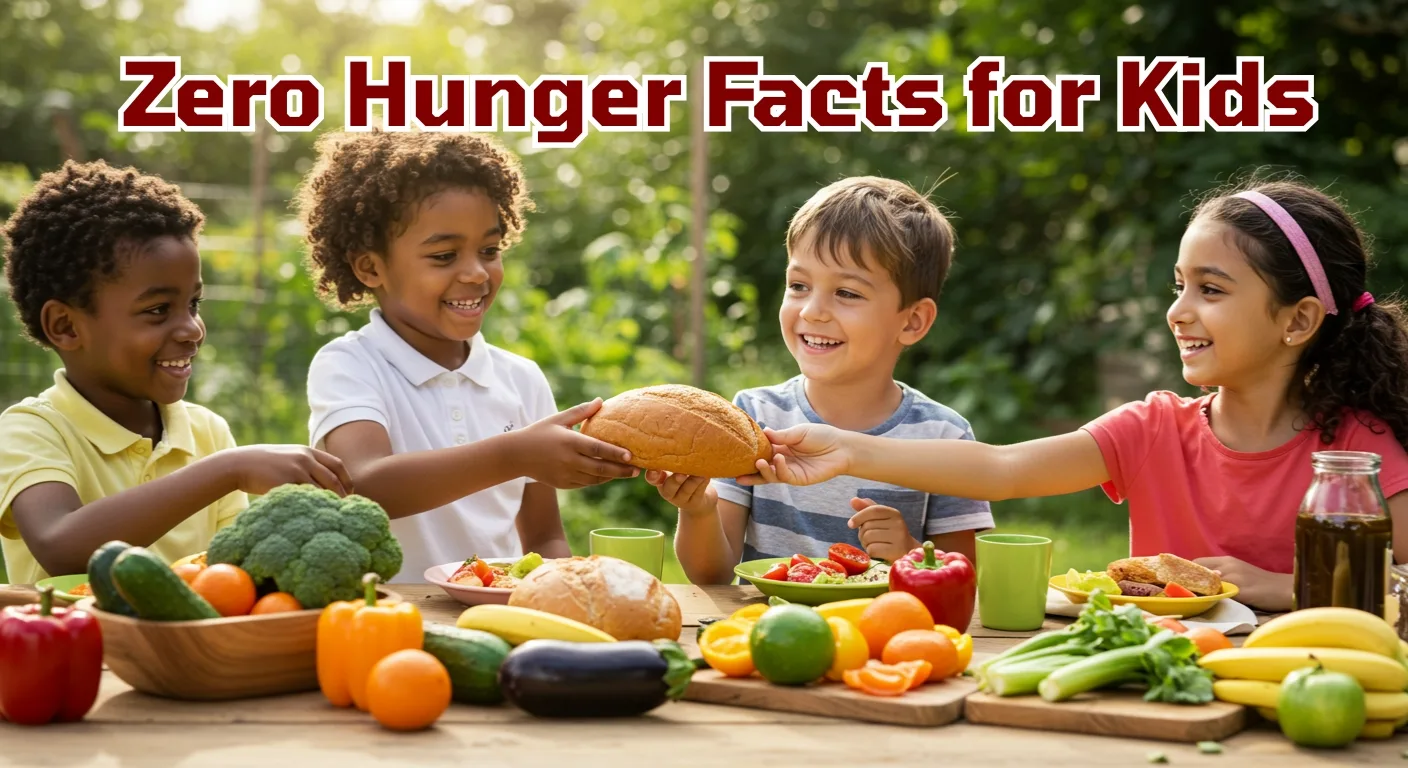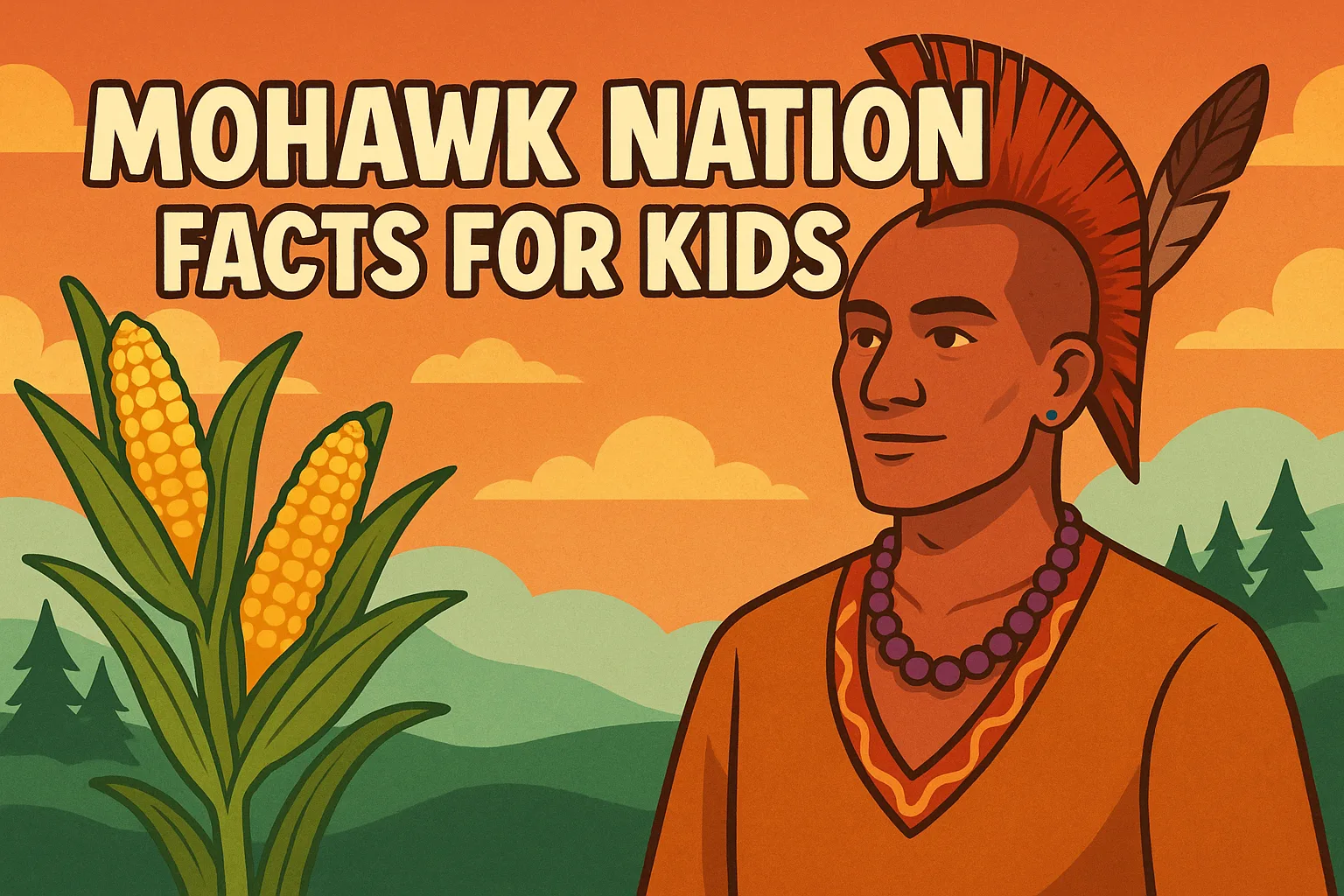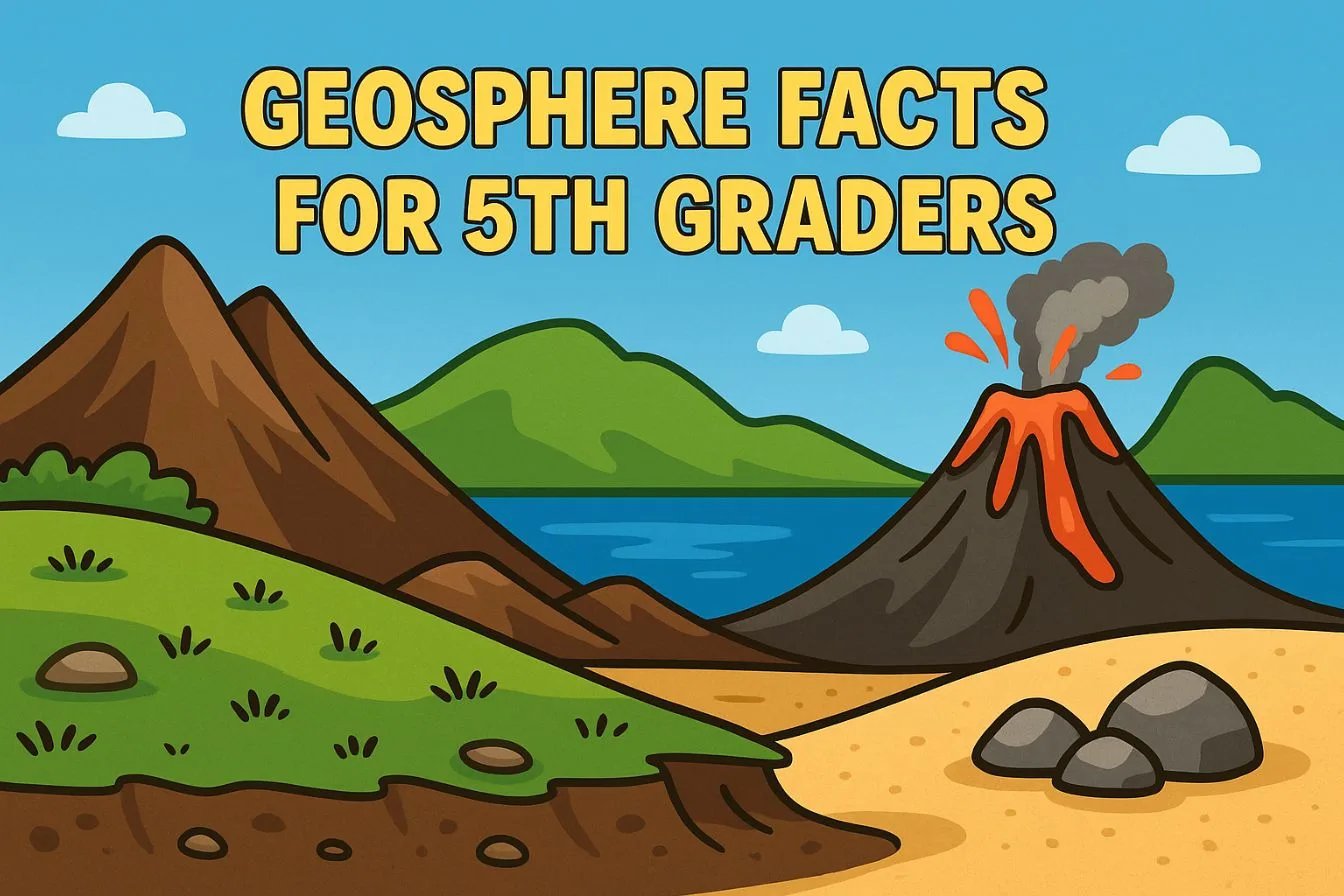Puffin also known as sea parrots and clowns of the sea, is beautiful sea bird. We have gathered a complete set of Puffin Facts For Kids that will help you in learning all about Puffins. You are going to learn Puffin Bird Facts about its name, scientific classification, meaning, evolution, species, appearance, size, weight, beak facts, habitat, swimming, diving, lifespan, diet, sound, lifecycle, reproduction, baby puffin, predators, population, conservation status, adaptations and many other interesting & fun facts about the Puffin,
Puffin Facts For Kids
1. What Is A Puffin Bird – Puffin Definition
- A puffin bird is a bird of any three small species of alcids or auks.
- It belongs to the bird’s genus Fratercula.
- All the members of puffin birds have bright-colored beaks during the breeding season.
- Puffins are the pelagic seabirds, which means they primarily feed through diving in the waters of the open ocean.
- Two species of puffin birds are found in the North Pacific Ocean while the third one is found in the North Atlantic Ocean.
- They make their large breeding colonies on the offshore islands or coastal cliffs.
- All the puffin birds have specially adapted short wings for swimming.

2. Puffin Scientific Name
- The scientific names of the puffins are:
- Fratercula arctica (Atlantic puffin)
- Fratercula corniculata (Horned puffin)
- Fratercula cirrhata (Tufted ot crested puffin)
3. What Does Puffin Mean – Puffin Meaning
- Puffin means a seabird with a large head and bright-colored triangular-shaped massive beak, who inhabit the northern and Arctic waters and nest in holes.
4. Why Are Puffins Called Puffins
- The word “Puffin” is used in the sense of puffed, that is swollen.
- Originally, this word referred to the salted, fatty flesh of young Manx shearwater birds.
- It is an Anglo-norman word, which was used for the preserved carcass of nestling Manx shearwater.
- Probably, puffins are called puffins because their stocky bodies look puffed and swollen.
5. Puffin Classification – Puffin Taxonomy
- The following is the scientific classification or taxonomy of the puffin:
| Kingdom | Animalia |
| Phylum | Chordata |
| Sub-phylum | Vertebrata |
| Class | Aves |
| Order | Charadriiformes |
| Family | Alcidae |
| Tribe | Fraterculini |
| Genus | Fratercula |
| Species |
|
6. Where Do Puffins Come From – Puffin Evolution
- The oldest fossil of alcid is Hydrotherikornis discovered in Oregon that dates back to the Late Eocene.
- Fossils of the extinct species of puffin, Dow’s puffin (Fratercula dowi) discovered on the Channel Islands of California belongs to the Late Pleistocene or early Holocene epoch.
- It is believed that the tribe Fraterculini has a primary origin in the Pacific because of their large diversity there (two of the three extant species of the puffins are from the Pacific).
- Fossil records of Fraterculini discovered in the Pacific along with three fossil species of Rhinoceros auklet (Cerorhinca) date back to as far as the middle Miocene to late Pliocene of northern Mexico and southern California.
- Although no records exist in the Atlantic that belongs to the Miocene, a further examination of the materials discovered in North Carolina indicated that there was a greater diversity of puffins in the Atlantic during the early Pliocene as it is today in the Pacific.
7. What Are Puffins Related To
- Puffins are closely related to the Rhinoceros auklet (Cerorhinca monocerata).
- Both belong to the same family and compose together the sub-family Fraterculini.
8. Puffin Species – Types Of Puffins
- There are three species or types of puffins:
Atlantic puffin (Fratercula arctica)
- It is the smallest of all the puffin species. It is found in the regions of the North Atlantic.
Horned puffin (Fratercula corniculata)
- It is a medium-sized puffin species found in the North Pacific regions.
Crested puffin or tufted puffin (Fratercula cirrhata)
- It is the largest of all the puffin species.
- It is also found in the North Pacific regions.
9. What Does A Puffin Look Like – Puffin Appearance
- Puffins are seabirds with stocky bodies, short wings, and short tails.
- They have black plumage at the upper parts of their bodies and brownish-grey or white at the underparts.
- They have mainly white faces and black cap-like plumage on the head.
- They have large beaks that become colorful during the breeding season.
- They have orange-red or yellow-orange webbed feet, which usually match their beak in color.
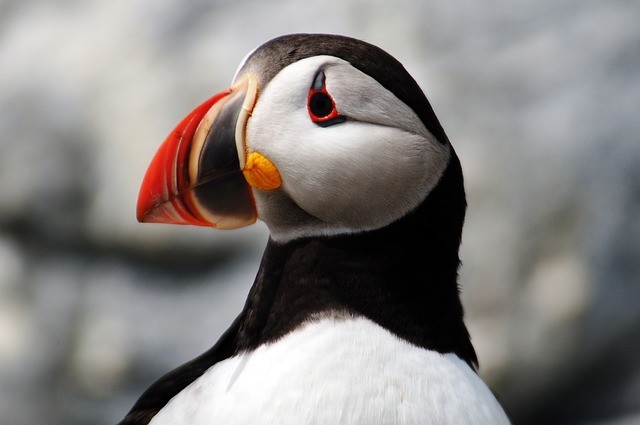
What Color Is A Puffin – Puffin Color
- Puffins have plumage coloring much like penguins.
- The upper regions of their body have black color while the underparts have white or brownish-grey color.
- They have a white face and a blackhead, which looks like a cap.
- Their feet have orange-red or yellow-orange color.
- They have a colorful beak during the breeding season.
10. What Size Is A Puffin – Puffin Size
- Atlantic puffins have 10 to 13 inches (25.4 to 32 cm) body length and up to 21 inches (53 cm) wingspan.
- Horned puffins have up to 15 inches (38 cm) body length and 23 inches (58 cm) wingspan.
- Tufted or crested puffins also have up to 15 inches (38 cm) body length but a wingspan of about 25 inches (63.5 cm).
How Tall Is A Puffin – Puffin Height
- The usual standing height of puffins is up to 10 inches (18 cm).
- Their height is equal to around a quart jug of milk.
How Tall Is An Atlantic Puffin
- Atlantic puffin stands about 10 inches (18 cm) tall.
11. How Much Does A Puffin Weigh – Puffin Weight
- An adult Atlantic puffin has up to 496 g (17.5 ounces) weight.
- Horned puffins have up to 620 grams (21.8 ounces) weight.
- Tufted or crested puffins have a bodyweight of 780 grams (27.5 ounces).
12. Puffin Beak Facts
- Puffins have a large beak or bill, which changes color throughout the year.
- It becomes brightly colored during the breeding season in spring.
- The beak and feet of a puffin usually match in color.
- When the beading season passes, they shed the colorful outer part of their beaks.
- Their small and dull-colored true bill can be noticed in the winter.
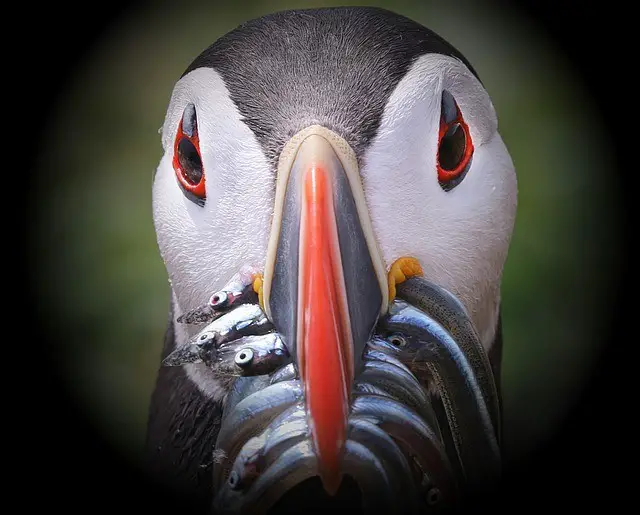
13. Where Do Puffins Live – Puffin Habitat – Puffin Natural Habitat
- Puffins are pelagic seabirds and live in the open ocean.
- Puffins do not need land for most of their lives.
- When not swimming, they would be found resting on the waves.
- During the breeding season, they return to the land and build their nests in the steep mountain cliffs or deep burrows.
- About 60% of the world’s entire puffins live near Iceland.
- The habitat range of the three puffin species is:
Where Do Atlantic Puffins Live – Atlantic Puffin Habitat
- They inhabit the North Atlantic coasts and islands. Their habitat range covers the coasts of northern Europe, northern France, the British Isles, the Faroe Islands, Iceland, Greenland, Norway, Atlantic Canada, and then Maine in the south. They spend their winters south to Morocco and New York.
Horned puffins
- They are found in the North Pacific region. Their habitat range covers the coasts of Serbia, Alaska, and British Columbia. They spend their winters south to California (United States) and Baja California (Mexico).
Tufted or crested puffins
- They are also found in the North Pacific region. Their habitat range covers British Columbia, all over southeastern Alaska and the Aleutian Island, the Kuril Islands, Kamchatka, and all over the Sea of Okhotsk. They spend their winters south of Honshu (Japan) and California.
Puffin Island
- The existing or former island breeding sites of puffins are also known as puffin islands.
- Currently, there are around 8 isles in the world that are named Puffin Island, because these islands are former or current homes to the breeding colonies of puffins.
- The most famous Puffin Island is an island located off the eastern tip of Anglesey island, Wales (United Kingdom).
- It is an uninhabited island and is a Special Protection Area for wildlife.
- The former name of the island was Priestholm.
- The island is a breeding site for a large number of Atlantic puffins, due to which it got its name the “Puffin Island”.
Puffin Colony
- Puffins breeds in colonies on offshore islands or coastal cliffs.
- In every spring and summer, they form large breeding colonies where they make burrows, lay and incubate eggs, and raise their young ones.
Largest Puffin Colony
- The world’s largest puffin colony is in the Wastmann Isles, Iceland.
- There, scientists estimated around 1.1 million nests of puffins in 2009.
- While the number of individuals was estimated as 4 million.
Where Do Puffins Live Map – Puffin Habitat Map
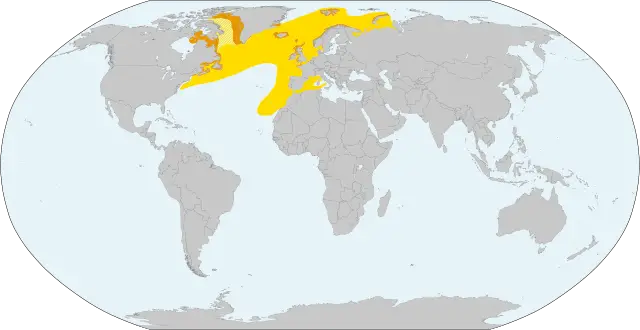
14. Can Puffins Swim – Puffin Swimming
- Yes, puffins are excellent swimmers.
- The short wings of puffins are specially adapted for swimming.
- When swimming, puffins stroke underwater through their wings with a flying technique.
- They use their webbed rudder-like feet to steer.
15. How Deep Can Puffins Dive – Puffin Diving
- Puffins can dive as deep as 60 meters (200 feet).
- Puffins dive underwater to get their food.
- They usually stay for only 20 to 30 seconds underwater.
- However, they can dive at the depth of up to 200 feet.
16. How Long Do Puffins Live – Puffin Lifespan
- Puffins live for around 20 years in the wild.
Atlantic Puffin Lifespan
- The average lifespan of Atlantic puffins in the wild is 20 or more years.
17. What Do Puffins Eat – Puffin Diet
- Puffins are carnivores in nature and primarily eat small fish.
- They also eat crustaceans, polychaete, worms, zooplanktons, and other marine invertebrates.
- Fish is their favorite diet than zooplanktons and other marine invertebrates.
- They would eat crustaceans along with fish during the winter season.
- The diet of puffins varies from colony to colony because the variety of fish found around their breeding site differs from region to region.
- They feed their chicks several times a day mainly with small marine fish.
- Puffins do not regurgitate the swallowed food and have a special ability to hold several small fish in their beaks at once.
- They hold it crosswise and sometimes the number of fish reaches over a dozen.
- The beaks of puffins have a unique hinging mechanism. The biting edges of both upper and lower parts of their beak can meet at any of several angles. This property of their beak makes it possible to hold several fish at a time.
- Due to this ability, they can make long foraging trips and can carry more food for their chicks in one visit.
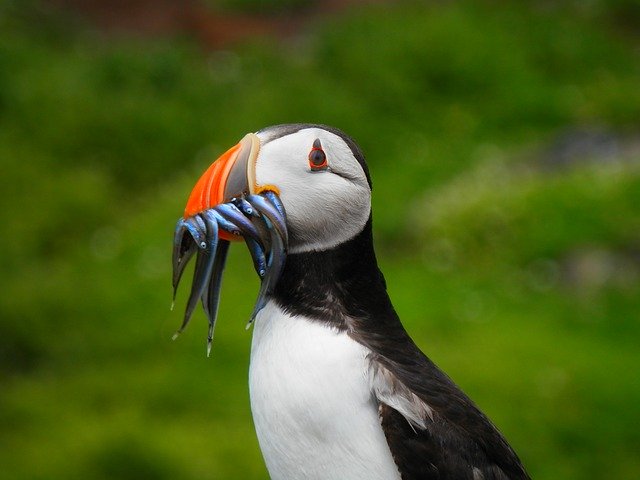
What Fish Do Puffins Eat – What Kind Of Fish Do Puffins Eat
- Puffins primarily eat small fish species, such as;
- Capilen
- Hake
- Herring
- Sand eel
What Do Atlantic Puffins Eat
- Atlantic puffins also eat small fish as their major diet.
- However, they also eat zooplankton and crustaceans.
- The major fish species Atlantic puffins eat are capilen, herring, hake, and sand eel.
What Do Tufted Puffins Eat
- Tufted puffins also eat small fish as their primary diet.
- They also eat zooplankton and crustaceans like other puffin species.
18. Do Puffins Have Teeth
- Puffins do not have actual teeth like humans and other large animals.
- However, many small spines exist on their upper palate. They also have a rough ending of their tongue, which allows them to grab the slippery prey.
- Both parts of their beaks also can meet at several angles. All these factors allow them to hold several fish in their beaks at once.
19. What Sound Does A Puffin Make – Puffin Sound – Puffin Noise
- Puffins usually stay silent at sea.
- At the breeding sites, males make pig-like grunts for attracting female mates.
- They make loud growling sounds from their underground burrows similar to the sound of a muffled chainsaw.
Atlantic Puffin Sound
- Atlantic puffins also stay silent at sea.
- At the breeding colony, males make piglike grunting sounds.
- Like other puffins, Atlantic puffins also make calls like a muted chainsaw from their underground burrows.
20. Puffin Life Cycle
- The life cycle of puffins starts when they become mature at the age of 3 to 5 years.
- A puffin searches for a suitable mate, and then the couple builds a nest on the bedding site where the female mate lays an egg.
- The couple collectively incubates their egg and raises the chick.
- The chick then leaves the nest after 45 days of its life.
- He spends 3 to 5 years at sea and during that time learns about the feeding grounds and choosing a suitable mate.
- Puffins live for around 20 years in the wild.
21. How Do Puffins Reproduce – Puffin Reproduction
- Puffins reproduce in large breeding colonies at the coasts or islands.
- Male puffins make piglike grunting sounds to attract female mates.
- They build nests in the form of burrows in soil or rock cliffs.
- In Atlantic puffin species, the males build nests and show strong fidelity to the nest site.
- Atlantic and tufted puffins dig burrows in the soft soil to make their nest.
- Tufted puffins dig about 2.75 meters (9 feet) long tunnels, which lead to their burrows.
- Atlantic puffins usually lined their burrows with grass, leaves, and feathers. They sometimes use the burrows of rabbits to breed.
- Horned puffins make their nests on the rock cliffs or crevices. Both the mates cooperatively build their nest, which usually has around 1 meter (3.3 feet) depth, and end in a chamber.
- Female puffins lay a single egg and both the partners cooperatively incubate their egg, turn by turn.
- The eggs have creamy white and sometimes slightly lilac color.
- A puffin incubates its egg by holding it against its brood patch with its wings.
- After the incubation of the egg for 40 to 45 days, a chick hatches from the egg.
- Both the parents feed the chick for another 40 to 45 days until it fledges (develop wing feathers and become capable of flight).
- A puffin chick usually fledges at night.
Puffin Breeding Season
- The spring and summer (from April to late July) is the breeding season of the puffins.
- A puffin lays an egg in late April or early May.
- The chick hatches in mid or late June.
- The parents feed the chick until it fledges in late July.
Puffin Nesting Season
- Spring (the start or mid of April) is the nesting season of puffins.
Puffins Mate For Life
- Puffins made long-term relationships with their mates, however, not exclusively for life.
- In the animal world, puffins are remarkably monogamous and most of them have the same mate for many years.
- Some puffins have had the same mate for around 20 years.
22. Baby Puffin Facts
What Is A Baby Puffin Called
- A baby puffin is called puffling or chick.
What Do Baby Puffins Eat
- Parents of the baby puffins feed them with small fish.
- A baby puffin, known as a chick or puffling, hatches after the incubation of the egg for 39 to 45 days.
- It has a covering of grey down feathers and has a dull grey color of feet and beak.
- It depends on parents for food and protection.
- The parents take their turns to feed it with small fish several times a day.
- It stays in the burrow or nest for up to 45 days till it fledges (develop wing feathers and become able to fly).
- Baby puffins usually fledge at night.
- A baby puffin spends the first three to five years of its life at sea until it becomes mature and capable to breed.
23. What Are Puffin Predators – What Eats Puffins
- The following are the natural predators of puffins:
- Hawk
- Eagle
- Gulls
- Skuas
- Fox
- Dogs
- Cats
- Weasels
- Rats, which mainly target their eggs
- Human beings are the major predator of puffins and hunt them for food. On the Faroe Islands, puffin’s meat is considered a delicacy.
Atlantic Puffin Predators
- The aerial predators of Atlantic puffin are also hawks, eagles, gulls, and skuas.
- Cats, dogs, and foxes also hunt them when they are closer.
- A human being is the biggest predator of Atlantic puffins. In Iceland, Atlantic puffin is not legally protected and its meat is part of the national diet. There, Atlantic puffin’s meat is commonly included in the hotel menus.
Do Seagulls Eat Puffins
- Yes, seagulls or gulls (especially great black-backed gulls) eat puffins and are one of their major natural predators.
Do Seals Eat Puffins
- Yes, seals are known for killing and eating puffins.
24. Puffin Adaptations
- Puffins have many adaptations to live in the open sea and eat seafood. The major adaptations are:
Waterproof plumage
- Puffins have a waterproof covering of plumage which provides them insulation underwater and keeps their body temperature stable.
- The black and white color of their plumage provides them camouflage. When at the sea, the aerial predators can not see them against the dark while they look like a sun-light reflection to underwater predators.
Short wings and webbed feet
- Puffins have specially adapted short wings and webbed feet, through which they can swim with a special flying technique.
- They can also beat their short wings 300 to 400 times per minute and can fly as fast as 64 km/h.
Large and serrated beak
- Puffins have large and serrated beaks. The upper and lower parts of their beak have a special hinging ability to meet at several angles.
- It allows them to hold more than 10 small fish at a time in their beak.
Rough tongue and palate
- Puffins have a rough ending of the tongue and spiney upper palate of their beak.
- It allows them to firmly grasp so many slippery fish at a time in their beak.
Puffin Behavioral Adaptations
- Puffins are solitary at the sea. When they return to the land at the start of their breeding season, they come to the same burrow site every year. It is unknown how they navigate back to their home site. Maybe, they would use smell, sounds, visual reference points, the magnetic field of the Earth, or probably even the stars.
- They do not make nests like other birds. They dig deep burrows and are energetic burrow engineers. Mostly, both the mates take part in digging their burrow.
- Puffins make long-term relationships and have the same mate for many years. Some puffin mates are observed to stay together for up to 20 years. The couple often reunites at their breeding burrow when they come back to the colony.
- Puffins communicate through vocals and walking postures. To show dominance, a puffin slowly walks with an upright posture with fluffed chest feathers and tilted tail while jerking its head.
- Like penguins, puffin mates also incubate their egg turn by turn. When the chick hatches, both the parents take turns feeding the chick several times during the day.
24. Are Puffins Extinct – Are Puffins Endangered – Why Are Puffins Endangered
- No, puffins are not extinct.
- No, puffins are not endangered but their population is declining.
- The following are some of the major factors that are responsible for their decreasing population:
Hunting
- Excessive hunting of puffins for meat, eggs, and feathers (used in bedding) is a major reason for their decreasing population.
- Puffin is an easily accessible food for island dwellers and coastal communities, which have few natural resources.
- Atlantic puffin is now protected through legislation in many countries. However, it is not protected in Iceland where its meat is considered a traditional delicacy.
- On Grimsey (a small Icelandic island), as many as 200 Atlantic puffins can be hunted only in a single morning.
Pollution
- Pollution is another factor that causes a threat to the puffin’s survival.
- Atlantic puffins are especially susceptible to human actions and disasters (such as oil spills) as they spend their winters on the open ocean.
- Spilled oil in the ocean causes the puffins’ plumage to become oily, due to which its insulating ability reduces and the puffins become more vulnerable to temperature fluctuations.
- Oily plumage also makes them less buoyant in the water.
- It causes the death of many puffins and the others inhale and ingest toxins while trying to remove oil from their plumage through preening.
- Inhalation and ingestion of the toxins cause inflammation of their gut and respiratory system, as well as, lead to kidney and liver damage.
- This trauma causes harm to the developing embryos and reduces reproductive success.
Climate change
- Climate change also influences the population of puffins.
- Climate change contributes to an increase in the surface temperature of the sea that affects the availability of main food items for the puffins, especially for the chicks.
Predators and parasites
- Predators of the puffins (gulls, hawks, eagles, skuas, fox, cats, dogs, etc) make less contribution in their population decline.
- Parasites of the puffins are tick Ixodes uriae and fleas; Ornithopsylla laetitiae, Spilopsyllus cuniculi, Ceratophyllus gallinae, Ceratophyllus borealis, and Ceratophyllus garei.
25. Puffin Endangered Status – Puffin Conservation Status
- Puffins are not endangered.
- The following is the conservation status of the three puffin species on the IUCN Red List:
| Puffin species | Conservation status |
| Atlantic puffin | Vulnerable |
| Horned puffin | Least Concern (population decreasing) |
| Tufted puffin | Least Concern (population decreasing) |
26. How Many Puffins Are Left In The World – Puffin Population
- The following is the estimated population of the puffin species:
Atlantic Puffin Population
- The estimated population of the Atlantic puffins in Europe is between 4.77 to 5.87 million pairs.
- Europe is home to more than 90% of the world’s total Atlantic puffin population.
- Their estimated population in Europe is between 4,770,000 to 5,780,000 pairs, which is equal to 9,550,000 to 11,600,000 individuals.
- 60% of the world’s total Atlantic puffins make their colonies only in Iceland.
Horned puffin
- The estimated population of horned puffins is 1.2 million (1,200,000).
- Around 300,000 are found in Asia while the remaining 900,000 are found in North America.
- In the Alaska Peninsula, they are highly concentrated with an estimated number of 760,000.
- Surveys on their population suggest an overall decline of up to 79% from 1972 to 1998.
Tufted puffin
- The total estimated population of tufted puffins is 2.97 million individuals.
- Another source (del Hoyo et al. 1996) estimates their population as 3.5 million individuals.
27. Fun Facts About Puffins
- Puffins have nicknames; Sae Parrots or Clowns of the Sae.
- In Iceland, the fresh raw heart of a puffin is eaten as a traditional delicacy.
- The weight of an adult puffin is around equal to a can of Coke.
- Puffins are vocal at their breeding colonies and chatter up a lot. However, they remain silent at sea.
- Puffins resemble penguins in their black and white plumage, diet, and some behaviors. However, unlike penguins, they are fastly flying seabirds.
28. Interesting Facts About Puffins
- The genus name of the puffins is Fratercula, which came from the Latin word for ‘Little brother’. This name was given to puffins because of their black and white plumage, which is said to resemble the monk’s robes once they wore.
- Beaks of the puffins change color throughout the year. During the breeding season, their beaks become brightly colored while dull grey during winters.
- The beaks of puffins have special serrations which help them to hold much fish. A puffin was observed holding 62 fish at a time in its beak.
- Puffins have specially adapted short wings which they use for swimming underwater with a flying motion along with their webbed feet.
- They are excellent flyers and can beat their short wings 300-400 times per minute and can achieve the fastest speed of 64 km/h (40 mph).
- In the year 2019, animal experts observed puffins using sticks to scratch themselves in two different geographic locations. This behavior of puffins indicates that they have a basic capability of using tools.
- 8 isles in the world are named Puffin Island because these are the former or existing homes of the large puffin colonies.
- Puffins make long-term relationships. A puffin may have the same mate for as long as 20 years.
- Puffin mates collectively incubate their eggs and then together feed and take care of their chick.
- Around 60% of the world’s total population of puffins breed in Iceland.

